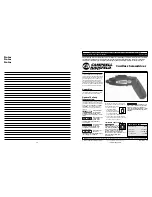
RIGOL
Chapter 3 Constant Current Test
DP1116A Performance Verification Manual
3-4
CC Load Regulation Rate (CC Load Effect)
CC load regulation rate refers to the variation of output current when the load
changes from full load to no load while the power supply is in CC mode. In the
following section, the specifications at 16V/10A scale and 32V/5A scale are tested.
Specification:
Load Regulation Rate, ±(Output PerOffset)
Current
< 0.005% + 250 μA
Test Procedures:
1.
Turn off DP1116A. Connect DP1116A, AC power supply, current sampling resistor,
electronic load and multimeter according to Figure 3-1.
2.
Turn on the AC power supply and set its voltage to 220 V. Set the electronic load
to short-circuit mode. At this point, the power supply scale to be tested is in CC
mode.
Note: the voltage of the AC power set in this step should be accordance with the
value selected by the voltage selector in the rear panel of DP1116A
3.
Turn on DP1116A. Press 16V/10A at the front panel to set the scale to be
tested to 16V/10A. Set the voltage and current of the scale to be tested
according to Table 3-1. Press On/Off to enable the output of the power supply.
4.
Turn on the digital multimeter and select the DC voltage measurement function.
Make sure that the power supply is in CC mode. Read the current reading (U
0
,
namely the voltage of the current sampling resistor) of the multimeter.
5.
Adjust the electronic load to make it work in CV mode and adjust its voltage to
make it approximate the rated output voltage of the scale under test. At this
point, the power supply scale under test is still in CC mode and is near full load
output. Read the current reading (U
1
, namely the voltage of the current sampling
resistor) of the multimeter.
6.
Calculate the current variation |U
1
/R
M
- U
0
/R
M
| and compare it with the
specification.
7.
Press 32V/5A at the front panel and repeat steps 1 to 6 to test the CC load
regulation rate at 32V/5A scale.
















































